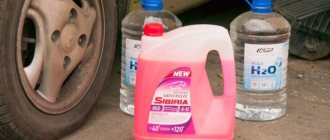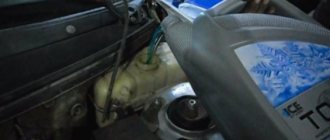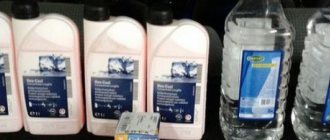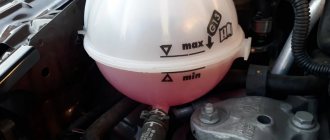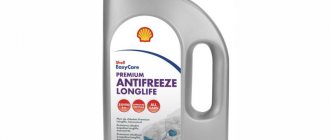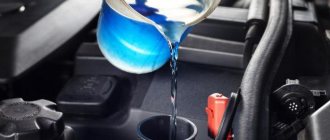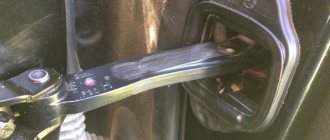Antifreeze, or antifreeze, is a liquid that is poured into the expansion tank of a car's cooling system. Literally translated into Russian, the word “antifreeze” means “anti-freeze.” This liquid does not solidify at subzero temperatures, cools the engine during operation and protects its elements from corrosion.
The composition of factory antifreezes includes ethylene glycol, propylene glycol, glycerin mixtures, monohydric alcohols, water and other substances. Sometimes flavorings are added to them.
Some car owners make antifreeze at home and note that it is not at all difficult. Look for the “recipe” further in the article.
But first, let’s figure out what is called antifreeze and what is antifreeze, and is there a difference between these liquids.
Domestic antifreeze - composition and labeling
This product is a liquid that circulates in the cooling system. It is also one of the varieties of antifreeze based on ethylene glycol, but only domestically produced. Its main tasks are to cool the engine in warm weather and prevent freezing of the working fluid in winter, as well as to protect the internal container from corrosion .
Depending on the labeling, the composition of the antifreeze, its density and, accordingly, its properties will vary. The following indices are used in the classification: A, M, K, 30, 40, 65. The letters indicate the type and are deciphered accordingly - automobile, modernized and concentrate. The numbers are the freezing temperature of this model of domestic antifreeze. The markings may also contain abbreviations for the names of manufacturers.
There are no coolants with a freezing point below 65 degrees Celsius, and it is the concentration of a substance such as ethylene glycol that provides different crystallization conditions. In addition to it, any, even domestic, antifreeze includes a set of additives, usually about 8–15, their purpose is to protect all pipes and components of the system from corrosion.
How to make anti-freeze: main points
Whatever composition you prepare, it should:
- clean the windshield from dirt and ice;
- remain liquid at subzero temperatures;
- be safe for both humans and machine parts.
That's all, perhaps, nothing more is required from the washer.
As a rule, the base of non-freezing liquid includes ordinary distilled water, alcohol and some additives for fragrance, coloring and improving cleaning properties. Among the alcohols used in production are methyl, ethyl and isopropyl.
Antifreeze - technical specifications and purchase rules
Once at the counter in an auto store, most are perplexed as to which color of antifreeze is better, because they were not prepared for such variety. The answer is not that complicated! This parameter does not affect any quality characteristics; it is just a dye added by the manufacturer. Its main purpose is to differentiate brands and allow them to be mixed, for example, in model “40” the liquid is often blue, and “65” is red. It is also used for safety, since without dye, antifreeze has a transparent white color.
The boiling point of antifreeze usually lies in the range of 104–112 degrees Celsius; as for imported antifreeze manufacturers, it reaches 120–130. When purchasing, one of the ways to check quality is to measure the density; a good indicator is the limit from 1.060 to 1.090 g/cm 3 . Before going to the store, you need to determine what brand of coolant is in your car, and to do this, you should refer to the owner's manual. You can also find application rules there.
Anti-freeze made from vodka
Vodka is found in almost every home, so to make anti-freeze from it, you need to take:
- 0.5 liters of vodka;
- 0.5 liters of clean water;
- 2 tsp. dishwashing detergents (for example, Fairy).
If you absolutely want a beautiful wash, add just a little blue or potassium permanganate to the solution.
The solution is completely safe for humans and machinery. This antifreeze is suitable for temperatures above –15 degrees. In cold weather there is no need to dilute vodka with water. But if the temperature outside the window is below - 30 degrees, then pure vodka will not save you, it will simply freeze.
We will replace the coolant yourself
Despite numerous warnings, antifreeze and antifreeze can be mixed, but some details need to be taken into account. It is best if the liquids are the same color and from the same manufacturer; you can also merge different colors, although the probability of success here is small, but still possible. So, you need to mix them together and wait for some time. If sediment appears in the new mixture, then you risk ruining the system, and if there is none, you can pour it all into the tank.
The appearance of sediment is a signal that the compounds are incompatible, and their mixture may have dangerous properties for your car. Now about the replacement process itself. Under no circumstances should you open the radiator cap when the engine is hot. Park your car in a place where there is no slope, this will ensure 100% drainage of the waste fluid. To remove the old compound, in addition to the top one, you also need to unscrew the bottom cap on the radiator. Do not forget to first place a sufficient container under it for waste.
After flushing the entire cooling system and tightly screwing the lower outlet plug, the long-awaited replacement occurs, where antifreeze is poured in in this case, it’s easy to guess - this is the upper hole. We fill the system with liquid as much as possible, and then seal it. To do this, we start the car and monitor the temperature sensor, it should show the norm, after that we top up the composition again to the top, and the process is completed. After all the operations performed, it is important to monitor the heating of the engine for some time; it should not exceed the permissible values.
The article presents the recipe for antifreeze , a substance intended for cooling in modern cars and other vehicles.
Since ancient times, drivers have poured water into the radiator of their car. To prevent it from freezing, a special substance was first added - ethylene glycol . The resulting mixture did not pose a danger to the cylinder block and radiator, since it turned into a viscous paste with small pieces of ice that were not prone to rupture of automotive equipment. For old cars that had cast iron engines and brass radiators, this substance seemed almost an ideal option, since it was also safe in terms of corrosion. This is how antifreeze appeared, which literally means “against frost.”
Homemade heating of antifreeze in the cooling system with glow plugs: design basics
The main structural elements of the heater are the block and spark plugs. The electrical part consists of large cross-section wires, a thermal relay (thermal sensor), a fuse and an electric relay designed for high current. The main difficulties are associated with the manufacture of the housing to accommodate the heaters.
Components
When designing antifreeze heating for a diesel engine with your own hands, you should pay special attention to the number of spark plugs: two or three heaters are quite enough. An excessive increase in the number of heat-generating components is fraught - each candle has a power of about 200-250 W and consumes considerable current.
Branded heater housings are available both at disassembly sites and in retail sales. One of the options is VAG 028 121 145B for three spark plugs. Price – about 2,000 rubles. In addition to this product, it is recommended to purchase sealing rubber VAG 037 121 687. An alternative is to look at disassembly sites:
- JP GROUP 114505200.
- TRICLO 463201.
- Vaico V10-0962.
- MALO 116092.
- Renault 8200012119.
- Hyundai/Kia 97341-26100.
The VAG block is focused on one-way communication. Installing a plastic counter flange will help correct this issue. Its catalog number is VAG 026 121 144E. The cost is about 500 rubles. Alternative parts:
- VIKA 14253 (metal – 250 rubles).
- DELLO 301210144026E (plastic – 50 rubles).
- VAICO V100270 (plastic – 80 rubles).
- JP GROUP 1114500600 (plastic - 50 rubles).
- VAG 0261211452 (metal - 750 rubles).
For systems with automatic control, you could consider a splitter for a temperature sensor VAG 028 121 144N. But it is not recommended to use it - the sensor quickly heats up from the glow plug housing and turns off the equipment ahead of time. It is better to integrate an autonomous tee VAG 4A0 819 497.
Electrical components
The optimal temperature relay for the designed VAG 251 919 369V system. The chain breaking point is 60°C. The tape conductor design, rated for 100A, is quite suitable for the role of a power circuit fuse: VAG N10 525 506 or N10 424 905.
When choosing glow plugs for homemade heating of antifreeze, you must be guided by the parameters of the original N10 302 102:
- Thread – M12x1.25 mm.
- Installation depth – 21 mm.
- Voltage – 11.5 V.
The disadvantage of the original candle is that the “plus” can only be connected using a cap. The latter is available in official auto parts stores under the code 028 971 782A. As an alternative, solutions with a nut-mounted terminal are available:
- SWAG 30915956.
- FEBI 19223.
- Bosch 0 250 201 032.
The cross-section of the power wiring is at least 4 mm2. To form a power circuit, you will need a four-contact starter relay with a rated current of about 70A, a button, a diode informing that the heating system is turned on, and a 30A control relay (four contacts). The insurance part consists of two fuses with a nominal value of 100A and 30A.
As you retrofit a diesel engine with an antifreeze heater, it is important not to deviate from the main idea - improving the heat transfer of the standard stove. Based on this, it would be logical to install the housing assembled with a flange near the stove radiator. Integrating it into the pipe leading to the heat exchanger is the optimal solution. It is better to integrate the temperature sensor into the hose coming out of the cabin radiator.
Connection
The electrical circuit is shown in the figure. All connection technology requirements are met:
- The control signal to the second relay is supplied by the generator (pin D+). The transmission is carried out when the toggle switch is turned on - the lamp lights up only when the engine is running.
- The circuits are protected by fuses.
- The contacts of the executing relay are designed for high current.
When connecting the circuit, it is important to calculate the total load on the generator. The resulting current should not exceed the rated value produced by the “gene” at idle. If the condition is not met, the generator must be replaced with a more powerful model, otherwise the battery will be supplied with power. Under normal conditions, the voltage drop after turning on the heater does not exceed 0.6-0.7 V.
Homemade antifreeze heating for a diesel car aims to speed up the warming up of the engine and interior. The essence of its work is that glow plugs heat the coolant when the engine is turned on in a certain temperature range. The installation is easy to assemble yourself using components from VAG.
The heater fits into the inlet of the cabin radiator, the temperature sensor into the outlet of the heater. There are no special comments regarding the installation of performing equipment. Regarding the electrical wiring connection, the only warning is not to mix up the 30A and 70A relays.
First problems
Along with the improvement of cars, the first troubles appeared. As it circulated through the new cooling systems, the heated antifreeze absorbed the metal. So the impeller and the walls of the cylinder head channels were left without whole pieces. Research institutes immediately began to solve this problem and proposed using additives in the form of inorganic salts to reduce corrosion activity. They contributed to the appearance on the walls of metal surfaces of a layer resistant to ethylene glycol.
At the same time, another name for antifreeze appeared - antifreeze . It appeared in a rather interesting way. The first three letters came from the department at the institute that dealt with the problems of improving antifreeze - “Organic Synthesis Technology”. The ending -ol is a tribute to chemical terminology. This is how the country first became acquainted with antifreeze!
Antifreeze made from ethyl alcohol
The stronger the water-alcohol solution, the more resistant it is to frost. Base alcohol strength – 96% +/- 2%. Here is a table showing the ratio in which you need to mix water and alcohol in order to make anti-freeze from them at home for various weather conditions:
At home, you can also add a little essential oil for scent and a tablespoon of washing powder to the solution to increase cleaning properties. Just don’t pour the powder directly into the canister. Pour out 2/3 cup of water prepared for the solution and add the powder there. Stir and let sit. Then you can pour this into a non-freeze container, filtering out the sediment.
Often the recipe contains detergent. Choose a regular kitchen one that is non-aggressive towards metal and plastic.
It's great if you have some free ethylene glycol or antifreeze. Their use adds a couple of pluses to the characteristics of a homemade washer. Calculate the required volume yourself on the basis that for every degree below zero it is advisable to pour in 10–15 drops. It turns out that in severe frost you will need about 2 cups of ethylene glycol or antifreeze.
So are there any differences?
We repeat - any coolant is antifreeze. Antifreeze is also antifreeze. Most sellers usually call antifreeze a liquid more intended for domestic cars. Although, even under the guise of “antifreeze” you can buy low-quality goods. To be confident in your choice, we recommend purchasing antifreeze only from well-known and trusted manufacturers. Preferably with reference to product endorsements by recognized automotive brands.
Antifreeze made from vinegar
If you don’t have any alcohol or vodka on hand, you can make your own anti-freeze for your car at home using regular 9% apple cider vinegar. Yes, yes, from the same one that is in the kitchen of 99% of housewives. Cheap and cheerful!
Just take half a liter of vinegar, the same amount of clean water and a couple of spoons of dishwashing detergent. Mix everything, and the washer is ready. True, in cold weather it will freeze quickly. It can be used up to a maximum of –10 degrees. Vinegar also smells strongly and, when used for a long time, spoils the pipes: it makes plastic and rubber less elastic and more fragile.
Detailed antifreeze recipe
Of course, not every driver can afford to buy expensive antifreeze from well-known manufacturers and suppliers. Most likely, this is why many car owners began to look for an antifreeze formulation in order to save financial resources. In reality, everything turned out to be not so simple. Large companies do not give away trade secrets, which, without a doubt, include product recipes. This is their profit - everything is logical and understandable here. I had to experiment for a long time.
But with the development of information technology, data has become more accessible. In particular, databases of patents from the times of the Soviet Union were posted on the Internet, where you can find the antifreeze recipe. Here we present just a few options. Anyone with access to the network can significantly expand this database
How to make a good antifreeze at home
from
Evgeniy 11/16/2018, 07:24 pm 8.8k P 61 G Comments
How to make a good antifreeze for your car at home? Is it possible to make it from alcohol, vodka, vinegar and other available materials? What recipes exist and in what proportions should the ingredients be mixed so that the windshield washer does not freeze in the cold? And does it make sense to make anti-freeze at home yourself for sale? About all this in our article.
There are a lot of anti-freeze products on sale today. Different types, colors and smells. Accordingly, the quality is also different. And at the same time the prices are quite reasonable. If you don’t like one, you can buy another one at the nearest store. However, despite the wide selection and availability of omyvayka, Russian Kulibins are always trying to invent something of their own.
There are many recipes on the Internet on how you can make high-quality anti-freeze for cars at home: from alcohol, vodka, vinegar, windshield cleaner, even from moonshine. It tells you in what proportions to mix all this in order to make a good antifreeze with your own hands.
By and large, the game is not worth the candle. It's easier to buy than to bother with beakers. But let's imagine that there is no other way. For example, in the middle of winter you suddenly find yourself at the end of the world and there is simply nowhere to buy auto chemicals, but you have already used yours. Then you will have to make an antifreeze from available materials.
What cars is it intended for?
Antifreeze is a more specialized coolant that is suitable for sports cars and SUVs; as for antifreeze, it can be poured into expansion tanks of any makes and models of cars. It is manufactured as a universal cooling solution
. The chemical composition of the coolant is very rich in elements and components that serve not only as an anti-freeze agent, but also as an anti-corrosion substance. According to reviews from car dealerships, it is even suitable for trucks as an effective coolant.
Antifreeze from other means
If it so happens that you don’t have vinegar, alcohol, or even vodka at home, you can make anti-freeze in the washer with your own hands from ammonia, window cleaner or a good dishwashing balm. Here are the recipes:
- 0.4 l of window cleaning liquid (windshield wiper) + 0.6 l of water.
- 1 tsp. dishwashing detergent + 1 liter of water.
- 0.2 l of ammonia solution (ammonia) + 0.6 l. water.
Please note that all three types of washer are not designed for very low temperatures. They are more for the off-season.
Process description
You might be surprised that homemade antifreeze contains alcohol. After all, it is clear that, for example, at a negative temperature on the windshield, the alcohol will evaporate, leaving only water, which itself will quickly freeze. But ethylene glycol saves everything here. It reduces the volatile property of the solution, so the alcohol does not have time to evaporate.
Often, a one to two ratio is used to prepare a solution, that is, one part alcohol and two water are taken.
This ratio can be changed if the temperature drops much below zero. At an air temperature of minus five degrees, a five-liter canister requires 0.6 liters of alcohol, at minus ten - one liter, at minus fifteen - 1.25 liters, at minus twenty - 1.65 liters, at minus twenty five - two liters, at minus thirty – 2.5.
Next, add ethylene glycol. You will have to calculate how much it is needed yourself. 15 cubic centimeters of ethylene glycol are required for each thermometer mark below zero.
Please note that ethylene glycol, like the antifreeze that contains it, is poisonous. If you are very concerned about your health, replace ethylene glycol with propylene glycol. It is much more expensive, but does not have toxic properties.
If desired, you can add natural flavoring to homemade antifreeze.
. It will remove the alcohol smell. You can use, for example, essential oil. By adding ten drops of it, you will rid the antifreeze canister of unwanted odor. We also note that you can enhance the cleaning properties of the liquid by simply adding a tablespoon of laundry detergent to it. If you adhere to all the above recommendations, then you will get antifreeze with your own hands no worse than the factory one.
Source
How to make anti-freeze yourself: important rules
So, all the recipes on how you can make antifreeze right at home have been given to you. What else is required? So that your home washer does not harm the car and you too. That's why:
- If possible, choose components without a strong odor.
- Do not use components for preparing anti-freeze, which may damage the washer.
- Start with a test sample. First, make 100-150 grams of anti-freeze and test. Apply it to the glass and also place it in the freezer for a while to see if the solution freezes and how quickly it does.
